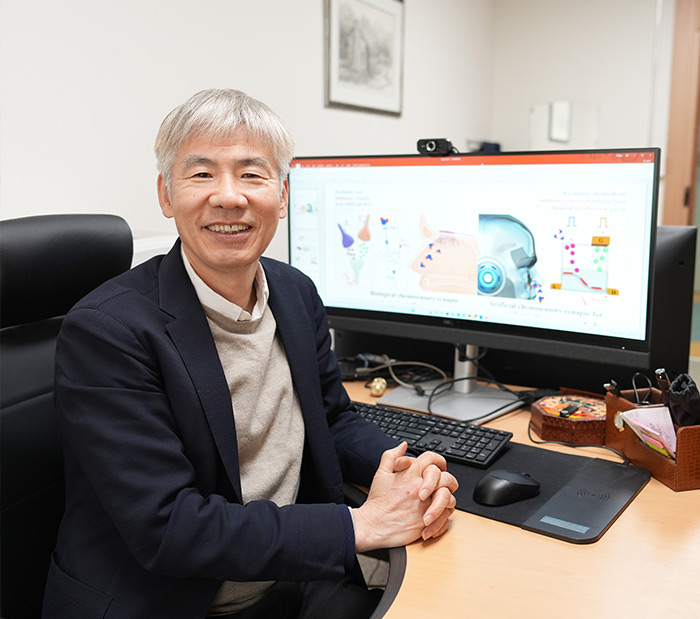Research Stories
Development of the artificial chemosensory neuronal synapse that mimic the biological olfactory system
Developing artificial sensory systems that can imitate the fundamental functions of the human sensory systems, such as the tactile, auditory, visionary, gustatory, and olfactory systems Prof. Nae-Eung Lee Advanced Materials Science and Engineering College of Engineering
Advanced Materials Science and Engineering
Prof.
LEE, NAEEUNG
Prof. Nae-Eung Lee's lab at the Department of Materials Science and Engineering has been developing artificial sensory systems that can imitate the fundamental functions of the human sensory systems, such as the tactile, auditory, visionary, gustatory, and olfactory systems. The development of an artificial sensory system that imitates the human sensory nervous system and performs intelligent and energy-efficient signal processing is expected to be applied in various autonomous systems, such as future robots and automobiles, as part of artificial intelligence technology. It is surprising that the human body is so sophisticated that it can pre-process all sensory information at the organ level before sending it to higher brain centers. Surprisingly, the human body is highly sophisticated and can pre-process all the sensory information at the organ level before transmitting it to higher brain centers. The lab's recent work on the artificial chemosensory neuronal synapse was inspired by the excitatory and inhibitory synaptic functions of the neurons and synapses in the human olfactory system and was published in "Nature Communications."
The team developed a simple device design by combining a chemoreceptive ionogel and a mixed ion-electronic conducting semiconductor channel. This design enables long-term retentive memory in response to chemical stimuli, with the memorized signals being erased by applying electrical stimuli to the device. The overall modulation of the signals is similar to the functions of the human nose, where different neuronal connections help to memorize and inhibit the signals from chemoreceptors.
Prof. Lee and their team, including co-corresponding author Dr. Atanu Bag and Ph.D. candidate Hamna Haq Chouhdry, discussed that this proposed device's concept can significantly reduce energy consumption and the amount of data required from sensors for neuromorphic signal processing. The data, pre-processed at the device level, can be directly utilized for software-based or hardware-based neuromorphic processing. This will lead to further research on artificial sensory systems and organs to implement neuromorphic cognitive functions that mimic the human sensory system.
This research was conducted at a university-focused research institute supported by the Ministry of Education and the Ministry of Science and ICT through the National Research Foundation of Korea and mid-career researcher support project, respectively. The research was published online in February 2023 in "Nature Communications" with the title "A flexible artificial chemosensory neuronal synapse based on chemoreceptive ionogel-gated electrochemical transistor," which was featured as research under the "Devices" section of Nature Communications Editor's Highlights webpage.
Fig. Top panel shows the comparison of the biological and artificial chemosensory synapse. The lower panel shows device operation under excitatory chemical and inhibitory electrical stimulus.


